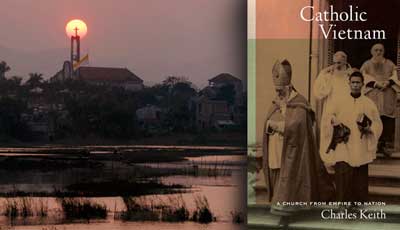By Sr. Maria Thuan Nguyen, The Catholic World Report
The call to love one’s heritage permeates the childhood of many Vietnamese-American Catholics. However, many historical accounts of the Catholic Church in Vietnam suggest a contradiction between being both a Catholic and a Vietnamese patriot. For example, biographies written by nineteenth-century missionaries portray Vietnamese Catholics as “victims of a pagan nation” who supported French rule. In his book Catholic Vietnam: A Church from Empire to Nation, Charles Keith, an Assistant Professor of History at Michigan State, debunks this reductionist model and astutely shows how the rise and fall of French colonialism, along with ecclesiastical and cultural factors, shaped the history of Catholicism in Vietnam.
Left: The sun sets over a Catholic church in Vietnam’s northern Ninh Binh province in this December 2013 photo (CNS photo/Kham, Reuters). Right: The cover of “Catholic Vietnam: A Church from Empire to Nation” by Charles Keith.

Keith’s exemplary scholarship shines through in his overview of how missionary and colonial expansion shaped Vietnamese Catholics’ relationships with other political forces. The emperors who governed Vietnam during the nineteenth-century viewed Catholicism as a Western import that undermined the foundations of Vietnamese hierarchy and society. Furthermore, some Vietnamese viewed Catholicism as inherently opposed to what it meant to be Vietnamese. This led to the destruction of Church property and violence towards priests and catechists, which Keith calls “communitarian conflict.”Increased French control over Vietnam in the late nineteenth-century further intensified communitarian conflicts and anti-French sentiments, resulting in the martyrdom of several thousand Catholics in 1885.
While Vietnamese Catholics venerated the martyrs, Keith rightly points out that this does not translate to Vietnamese Catholics supporting French colonialism. “Ruptures of French rule,” Keith explains, “led many Vietnamese—Catholics and others—to question long-standing social norms and forms of authority.” Also, some of the new missionaries’ immoral conduct and condescending treatment led many Vietnamese Catholics to undermine missionary authority, further straining the relationships between Vietnamese Catholics, French rulers, and French missionaries. According to Keith, the Vietnamese Catholics’ compounded animosity towards the French nurtured a desire for both a national Church and an autonomous nation.
One of the innovative aspects of Catholic Vietnam is Keith’s attempt to analyze the relationship between religion and politics. He points out that despite previous communitarian conflicts, Vietnamese Catholics, for the most part, saw no contradiction between being both a Catholic and a nationalist. Prominent twentieth-century Catholic leaders such as Nguyễn Hữu BÀi sought to strengthen Vietnam’s ties to Rome, and he and his friend Ngô Đình Khả (father of Ngô Đình Diệm, the first president of the Republic of Vietnam) displayed fervent loyalty to the Vietnamese monarchy. However, Keith seems to minimize how the Catholic faith pervaded these leaders’ actions. While he briefly discusses Nguyễn Hữu BÀi’s support of Marian devotions, Keith does not seem to recognize how both BÀi and Khả’s religious beliefs were the driving force behind their political motivations. Following in the Vietnamese martyrs’ footsteps, BÀi and Khả’s fidelity to their Christian faith took primacy over everything else. They zealously worked towards an autonomous Vietnam because they believed it to be God’s will for the Vietnamese people. Keith’s analysis does not fully take into account that for BÀi and Khả, as well as some other prominent Catholic leaders, following in the footsteps of the martyrs meant being patriots. Their political motivations were certainly important, but their Christian faith was the foundation for their political action. Keith’s understatement of this renders an incomplete examination of the connection between religion and politics.
In the second half of his book, Keith further explores how the emergence of a national Church led to an abundant support for national independence. In 1933, Nguyễn BÁ Tòng was ordained as the first bishop of Vietnam, marking a turning point for Vietnamese Catholics. The Catholic Church in Vietnam was transitioning from being a French Catholic mission to becoming a national Church. This cultivated nationalistic attitudes in both Vietnamese Catholics and non-Catholics. To the dismay of French colonialists and missionaries, prominent Catholic intellectuals contributed to the nationalist movement by publishing opinion pieces regarding different notions of nationalism. Nevertheless, relationships between Catholics and other nationalists, particularly the Communists, were strained. Many Catholics withdrew their support from the Democratic Republic of Vietnam (established after World War II), further damaging the relationship between Communist leaders and the Church. Ultimately, most Catholics favored Ngô Đình Diệm, a Catholic nationalist who would be the first president of the Republic of Vietnam in 1955. Keith argues, however, that Vietnamese Catholics were far from unified. He explains that many Vietnamese Catholics (as well as non-Catholics) criticized Diệm’s abuses and the corruption in his regime, leading to deep divisions among Vietnamese Catholics. These ruptures and political divisions resulted in a fragmented Church, leaving the question of the Vietnamese Church’s place in its nation’s history unanswered.
Read the full review by Sr. Maria Thuan Nguyen from The Catholic World Report.

